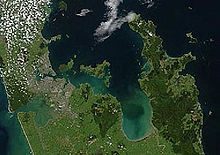- Mercury Islands
-
Mercury Islands Maori: (?) 
A true-colour image acquired by NASA's Terra satellite, on October 23, 2002. The Mercury Islands are just visible at top right, to the northeast of the Coromandel Peninsula.Geography Coordinates 36°35′S 175°55′E / 36.583°S 175.917°E Country The Mercury Islands lie off the northeast coast of New Zealand's North Island. They are located 8 kilometres (5 mi) off the coast of the Coromandel Peninsula, and 35 kilometres (22 mi) northeast of the town of Whitianga.
The main chain of the Mercury Islands consists of the large Great Mercury Island (also known as Ahuahu) to the west, Red Mercury Island (Whakau) to the east, and five much smaller islands between the two (Korapuki, Green, Atiu/Middle, Kawhitu/Stanley and Moturehu/Double Islands). Only the main island is inhabited – the others form part of a nature reserve. To the south of this chain numerous tiny islets lie to the north of the mouth of Mercury Bay. One lone island, Cuvier Island, lies 15 kilometres (9.3 mi) to the north of Great Mercury Island, although this island is not normally considered part of the Mercury Island group. Great Mercury Island is what remains of a Pliocene rhyolitic volcano.
Great Mercury Island is owned by Michael Fay, a former prominent New Zealand businessman who now lives in Switzerland. The private island, which features two luxurious residences, can be hired for around $20,000 NZD per day. U2's lead singer Bono and guitarist The Edge stayed on the island during U2's Vertigo concerts in Auckland in November 2006.
On November 30, 2009, Great Mercury Island hosted the first successful launch of Rocket Lab's suborbital Atea-1 sounding rocket. [1]
The group of islands is still occasionally referred to by the earlier name of Iles d'Hausse.
Coordinates: 36°35′S 175°55′E / 36.583°S 175.917°E
See also
References
- ^ "NZ's First Space Launch Saved By $6 Replacement Part". New Zealand Herald. 11-30-09. http://www.nzherald.co.nz/nz/news/article.cfm?c_id=1&objectid=10612593.
External links
- 'Geology – New Zealand's Geological History', from An Encyclopaedia of New Zealand, edited by A. H. McLintock, originally published in 1966. Te Ara – The Encyclopedia of New Zealand, updated 2006-09-26. Accessed 2007-04-15.
Categories:- Islands of New Zealand
- Volcanoes of New Zealand
- Thames-Coromandel District
Wikimedia Foundation. 2010.
